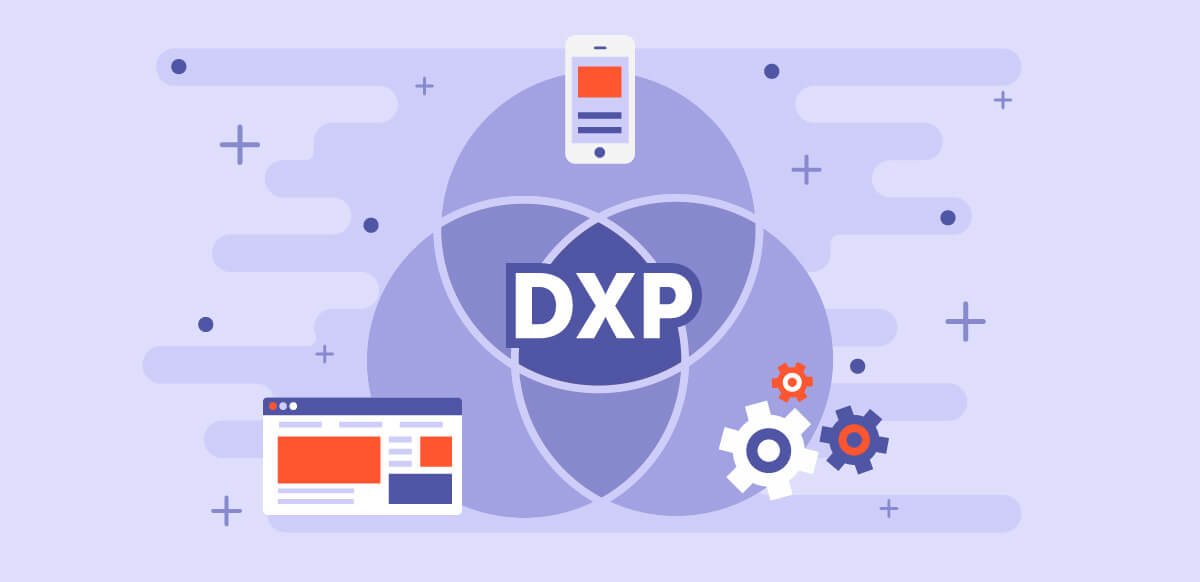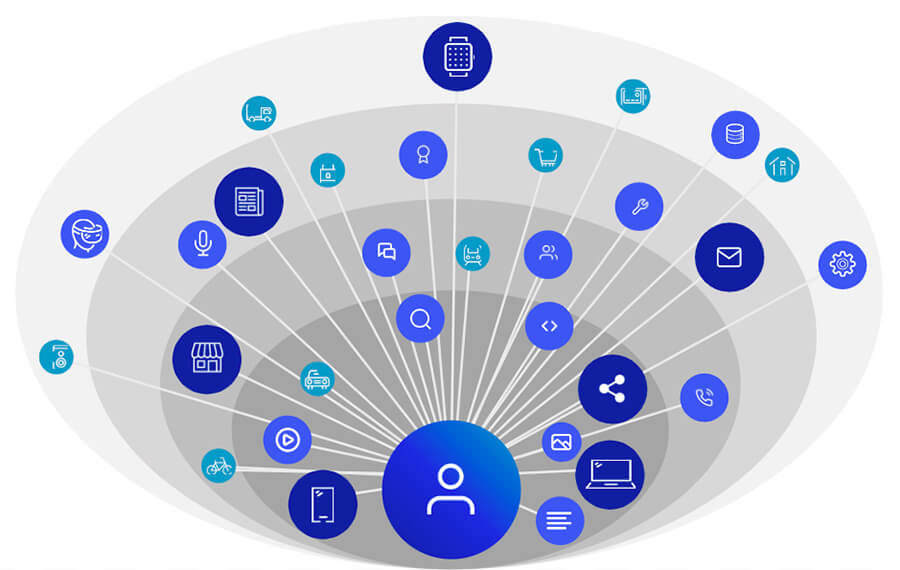The Rise of Digital Experience Platforms
If you’re mulling over the idea of diving into the realm of Digital Experience Platforms (DXP), chances are you need to catch up on outdated systems and murky competition. Perhaps you’re grappling with the frustrating limitations of your current tech stack, an eye-watering cost of ownership, questionable security, or even—dare we say it—nightmarish integration snafus?
So, what’s the big commotion about DXPs, and how do you navigate this labyrinthine landscape to pinpoint the one that meshes with your brand’s master plan, targets, and skill sets? In this riveting read, we’ll peel back the layers on the enigmatic DXP, dissect its indispensable role in crafting a cutting-edge digital roadmap, and furnish you with a compass for selecting that elusive perfect fit.
Understanding The Core Components of A DXP
Imagine a Swiss Army knife, but for the digital cosmos, that’s essentially what Digital Experience Platforms (DXPs) have morphed into. Once humble offspring of Content Management Systems (CMSs), today’s DXPs are more akin to digital maestros, orchestrating tasks for marketing virtuosos and IT whizzes—all on a single, unifying stage.
Sure, the core act still revolves around managing content, but an ensemble of critical players shapes the DXP symphony. Think search engines crooning to customer data while asset management jams with analytics. Don’t forget the opening acts—content marketing, experimentation, personalization, and others.
But wait, there’s more. This isn’t just a B2C or B2B extravaganza; even the B2E crowd gets VIP passes. Companies like Sitecore and Optimizely, which offer DXP and CMS solutions, have become household names, joining the ranks of WordPress, Contentful, and Webflow. Learn how our services can help you maximize your digital experience platform.
And lo and behold, our digital connoisseurs—tech analysts from the likes of Gartner and Forrester—have created their own Billboard charts. Here, DXP technologies get scrutinized, ranked, and showcased based on various factors, from customer data management to cloud prowess. This jazz is encapsulated in reports like Gartner’s Magic Quadrant and Forrester’s Wave, which dish out the highs and lows, the native talents, and the acquired skills of each DXP solution.
To wrap this up in a slick bow: A DXP isn’t just a one-hit-wonder. It’s your digital jukebox, ripe with tracks to amplify customer insights, harmonize operational flows, and belt out personalized experiences across various channels. All while keeping your brand’s chart-topping aspirations alive and kicking. So, why resist the groove?

Does The Choice of DXP Matter?
We conducted a survey grilling some 100+ mavens from the marketing and tech sectors—we dived into the murky waters of digital customer experience trends. Ah, the quest for the Holy Grail of decision-making insights! So, what gets the alarm bells ringing and sends companies scrambling to upgrade or swap out their DXP or CMS? The rogues’ gallery is familiar yet pressing: limited features, exorbitant ownership costs, language barriers, sunsetting platforms, integration hiccups, and the Sisyphean struggle to keep content fresh.
Please make no mistake: the DXP you pick is far from a trivial choice; it’s the linchpin of your digital gambit, shaping both the value you deliver to your audience and your shot at cybernetic stardom. Nail it, and you’ll unleash a cascade of boons that can supercharge your overall game plan:
Symphony of Unity: A top-tier DXP harmonizes with many other tech tools, orchestrating an unbroken, pitch-perfect customer odyssey across various channels and gadgets. Your audience won’t just stick around; they’ll become die-hard fans.
Bespoke Encounters: Imagine a DXP that’s also a mind-reader, sifting through heaps of customer data and taking AI and machine learning cues to tailor experiences that make each user feel like a VIP.
Slick Operations: A centralized hub for all things customer-related means saying sayonara to redundant tasks. Your team will zip through workflows powered by data, turbocharging efficiency and making your marketing tech a piece of cake to adopt.
Future-Proof Swagger: Your DXP isn’t just a here-and-now solution; it’s a forward-looking ally. This extensibility ensures you’re geared up for whatever curveballs tomorrow’s consumer whims or emerging technologies might throw your way.
To further explore the top-rated DXPs, check out this guide of the best digital experience platforms in 2024. Before you ink any contracts, though, don your investigative hat. Look into how easily this potential digital partner can evolve to accommodate digital asset management, marketing automation, or any future fancy needs you might conjure.

What to lookout for while selecting a DXP?
Navigating the labyrinthine world of Digital Experience Platforms (DXPs) isn’t an outing in the park. First up, clear your lens. Zero in on your business objectives and spell out, in no uncertain terms, what you seek to manifest in the digital realm with your spanking new DXP. This North Star will steer your expedition, aligning your tech arsenal with your grand vision.
The Anatomy of Your Ideal DXP:
1. The Web of Connections: Integrations
Think of your DXP as a digital socialite, hobnobbing within the grander realm of your tech stack. Can it strike up a conversation with your CRM, ERP, or marketing automation platforms? Jot down the “absolute-must-meet” tech profiles—like CMS, CRM, DAM, CDP, or even some avant-garde generative AI—that your DXP should comfortably vibe with. This mapping act will sift the wheat from the chaff while parading through your DXP options.
2. A Roof Over Your Head: Hosting & Infrastructure
Your DXP should be a homestead, not a mere pitstop—scalable, enduring, and up to the task of serving your growing clientele and content volume and eyeing a hands-off approach. A SaaS solution manages the nitty-gritty so you can focus on your core operations. Need to get under the hood? An on-premise model grants you the keys to the kingdom, which is ideal for stringent compliance demands.
3. Your Canvas, Your Rules: Flexibility
Every business is a peculiar beast, demanding a DXP that can adapt, not dictate. Headless architectures allow for an a la carte approach, letting you couple the front end of one provider with the back end of another. But beware: this à la mode setup puts you in the driver’s seat for ensuring cohesion and security, especially when you throw upgrades into the mix.
4. Crunching the Numbers: Budget
Let’s not kid ourselves; the price tag matters. Consider the upfront costs of doing a project and the ongoing fees for professional services, maintenance, and updates. Need help with how to weigh the pros and cons? Enlist a tech-savvy partner or agency to guide you through this labyrinth, from framing your goals to finalizing the nitty-gritty of implementation.

So, strap in! You’re not just picking software but courting a long-term ally for your digital foray. With your goals mapped and your wits about you, you’re well-equipped to delve into the DXP cosmos, cherry-pick the right tools, and carve out your corner in the digital universe.
Ready to jump in find your perfect DXP?
A carefully chosen DXP doesn’t just dress your digital strategy in bells and whistles; it becomes the conductor of your digital symphony, harmonizing every note to resonate with your business goals. Interested in unraveling the full breadth of what a DXP can bring to your table? We don’t just offer products; we serve as trail guides, helping you navigate the rich landscape of DXPs to squeeze every last drop of value from your investment. Reach out to us today or just give us a call at +1 (888) 633-0430 to get in touch with one of our experts.
